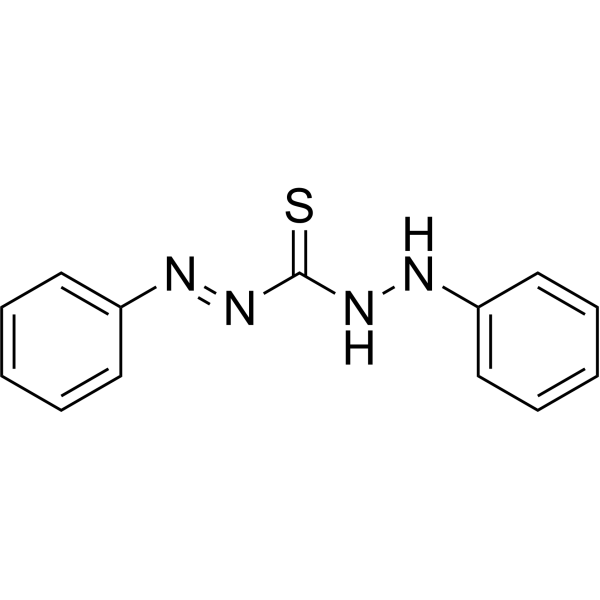Dithizone

Dithizone structure
|
Common Name | Dithizone | ||
|---|---|---|---|---|
| CAS Number | 60-10-6 | Molecular Weight | 256.33 | |
| Density | 1.2±0.1 g/cm3 | Boiling Point | 376.1±25.0 °C at 760 mmHg | |
| Molecular Formula | C13H12N4S | Melting Point | 168°C (dec.) | |
| MSDS | Chinese USA | Flash Point | 181.2±23.2 °C | |
| Symbol |

GHS07 |
Signal Word | Warning | |
|
Immunotoxicity in ascidians: antifouling compounds alternative to organotins-IV. The case of zinc pyrithione.
Comp. Biochem. Physiol. C. Toxicol. Pharmacol. 169 , 16-24, (2015) New biocides such as the organometallic compound zinc pyrithione (ZnP) have been massively introduced by many countries in formulations of antifouling paints following the ban on tributyltin (TBT). The effects of sublethal concentrations (LC50=82.5 μM, i.e., ... |
|
|
Long-term survival of allograft murine islets coated via covalently stabilized polymers.
Adv. Healthc. Mater. 3(7) , 1061-70, (2014) Clinical islet transplantation (CIT) has emerged as a promising treatment option for type 1 diabetes mellitus (T1DM); however, the antirejection drug regimen necessary to mitigate allograft islet rejection is undesirable. The use of polymeric coatings to immu... |
|
|
Feasibility of islet magnetic resonance imaging using ferumoxytol in intraportal islet transplantation.
Biomaterials 52 , 272-80, (2015) There is a clinical need for an alternative labeling agent for magnetic resonance imaging (MRI) in islet transplantation. We aimed to evaluate the feasibility of islet MRI using ferumoxytol, which is the only clinically-available ultrasmall superparamagnetic ... |
|
|
Dielectric spectroscopy for monitoring human pancreatic islet differentiation within cell-seeded scaffolds in a perfusion bioreactor system.
Analyst 140 , 6295-305, (2015) The long-term in vitro culture and differentiation of human pancreatic islets is still hindered by the inability to emulate a suitable microenvironment mimicking physiological extracellular matrix (ECM) support and nutrient/oxygen perfusion. This is further a... |
|
|
ROCK inhibitor is not required for embryoid body formation from singularized human embryonic stem cells.
PLoS ONE 9(11) , e100742, (2014) We report a technology to form human embryoid bodies (hEBs) from singularized human embryonic stem cells (hESCs) without the use of the p160 rho-associated coiled-coil kinase inhibitor (ROCKi) or centrifugation (spin). hEB formation was tested under four cond... |
|
|
Generation of insulin-producing cells from C3H10T1/2 mesenchymal progenitor cells.
Gene 562(1) , 107-16, (2015) Mesenchymal stem cells (MSCs) have been reported to be an attractive source for the generation of transplantable surrogate β cells. A murine embryonic mesenchymal progenitor cell line C3H10T1/2 has been recognized as a model for MSCs, because of its multi-lin... |
|
|
Hepatic stellate cells induce immunotolerance of islet allografts.
Transplant. Proc. 46(5) , 1594-600, (2014) Activated hepatic stellate cells (HSCs) possess strong immune inhibitory activity. The present study highlighted the protective role of HSCs in islet transplantation. Recipients were randomly divided into 4 groups: a diabetic group, an HSC-alone group, an isl... |
|
|
Pancreatic ductal perfusion at organ procurement enhances islet yield in human islet isolation.
Pancreas 43(8) , 1249-55, (2014) Pancreas preservation is a major factor influencing the results of islet cell transplantation. This study evaluated the effects of 2 different solutions for pancreatic ductal perfusion (PDP) at organ procurement.Eighteen human pancreases were assigned to 3 gr... |
|
|
Ultrasound-assisted surfactant-enhanced emulsification microextraction for the determination of Cd and Ni in tea and water samples.
Environ. Technol. 35(17-20) , 2401-9, (2014) A microextraction method based on ultrasound-assisted surfactant-enhanced emulsification using solidification of a floating organic droplet (UASEME-SFO) was evaluated for simultaneous determination of Cd and Ni in water and tea samples followed by flame atomi... |
|
|
Zinc-Dithizone Complex Engineered Upconverting Nanosensors for the Detection of Hypochlorite in Living Cells.
Small 11 , 4568-75, (2015) Current chemo/biosensors for hypochlorous acid or hypochlorite detections are usually limited to the submicromolar level because of their insufficient sensitivity, which is a problem because the concentrations in biological matrices is generally on the nanomo... |